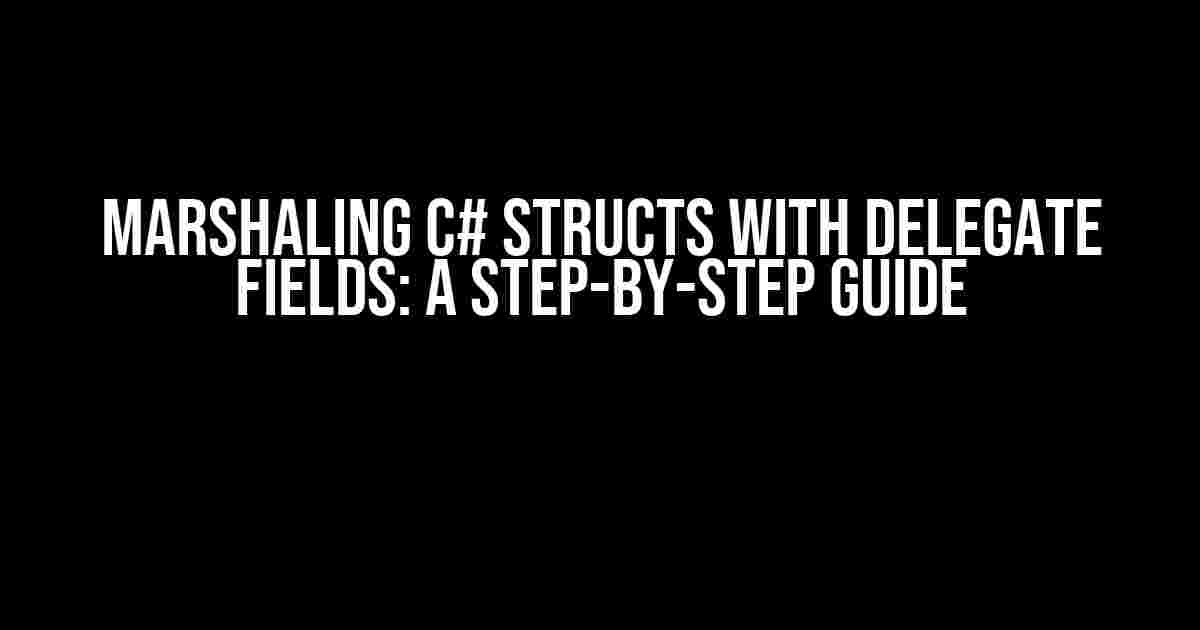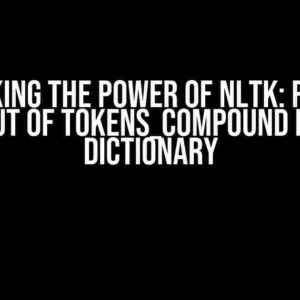If you’re struggling to marshal C# structs with delegate fields, you’re not alone. This complex topic has puzzled many developers, leaving them frustrated and confused. Fear not, dear reader, for today we’re going to demystify the process and provide you with a clear, concise guide on how to conquer this beast.
What is Marshaling, Anyway?
Before we dive into the nitty-gritty, let’s quickly cover the basics. Marshaling is the process of converting .NET data types into a format that can be understood by unmanaged code, such as C or C++. This is essential when interacting with APIs, DLLs, or other native libraries that don’t speak .NET.
In the context of C# structs, marshaling is crucial when working with P/Invoke (Platform Invoke) or COM Interop. However, things get tricky when your structs contain delegate fields. Delegates, as you know, are type-safe function pointers that can be used to invoke methods. But how do you marshal these delegates to unmanaged code?
The Problem: Marshaling Delegate Fields
The main challenge lies in the fact that delegates are .NET-specific constructs that don’t have a direct equivalent in unmanaged code. When you try to marshal a struct with a delegate field, the CLR (Common Language Runtime) doesn’t know how to translate the delegate into a format that the unmanaged code can understand.
This is where the magic of marshaling comes in. You need to tell the CLR how to convert the delegate field into a format that can be consumed by unmanaged code. But before we get to the solution, let’s explore the different types of delegates and how they’re marshaled.
Delegate Types and Marshaling
There are three types of delegates in C#:
- Single-cast delegates**: These are the most common type of delegate, which represent a single method.
- Multicast delegates**: These are delegates that can be used to invoke multiple methods.
- Async delegates**: These are delegates that are used for asynchronous method invocation.
When it comes to marshaling, single-cast delegates are the easiest to work with. You can use the MarshalAs attribute to specify the unmanaged type that the delegate should be converted to. For example:
[StructLayout(LayoutKind.Sequential)]
public struct MyStruct
{
[MarshalAs(UnmanagedType.FunctionPtr)]
public delegate void MyDelegate(string message);
public MyDelegate myDelegate;
}
In this example, the MyDelegate field is marshaled as a function pointer, which can be consumed by unmanaged code.
Marshaling Multicast Delegates
Multicast delegates are a bit more complicated. Since they can invoke multiple methods, you need to use a more sophisticated approach to marshal them. One way to do this is by using the MarshalAs attribute with the UnmanagedType.ByValArray type.
Here’s an example:
[StructLayout(LayoutKind.Sequential)]
public struct MyStruct
{
[MarshalAs(UnmanagedType.ByValArray, SizeConst = 2)]
public delegate void MyDelegate(string message);
public MyDelegate[] myDelegates;
}
In this example, the myDelegates field is an array of multicast delegates, which are marshaled as an array of function pointers.
Marshaling Async Delegates
Async delegates are the most complex type of delegate to marshal. Since they’re used for asynchronous method invocation, you need to use a combination of the MarshalAs attribute and the IAsyncResult interface.
Here’s an example:
[StructLayout(LayoutKind.Sequential)]
public struct MyStruct
{
[MarshalAs(UnmanagedType.Interface)]
public IAsyncResult myAsyncResult;
[MarshalAs(UnmanagedType.FunctionPtr)]
public delegate void MyDelegate(IAsyncResult asyncResult);
}
In this example, the myAsyncResult field is marshaled as an IAsyncResult interface, which represents the asynchronous operation. The MyDelegate field is marshaled as a function pointer that takes an IAsyncResult parameter.
Best Practices for Marshaling Delegate Fields
Now that you know how to marshal delegate fields, here are some best practices to keep in mind:
- Use the
MarshalAsattribute**: This attribute is essential for specifying the unmanaged type that the delegate should be converted to. - Choose the correct unmanaged type**: Depending on the type of delegate and the unmanaged code you’re working with, you may need to use different unmanaged types, such as function pointers or interface pointers.
- Be mindful of delegate lifetime**: When marshaling delegates, you need to ensure that the delegate remains valid for the duration of the unmanaged code’s execution. This may require manual memory management or using a pinned object.
- Test and verify**: Marshaling delegate fields can be complex, so make sure to thoroughly test and verify your code to ensure it works correctly.
Conclusion
Marshaling C# structs with delegate fields can be a daunting task, but with the right knowledge and techniques, you can overcome the challenges. By following the instructions and best practices outlined in this article, you’ll be able to confidently marshal delegate fields and interact with unmanaged code like a pro.
Remember to stay creative, experiment with different approaches, and don’t be afraid to ask for help when needed. Happy coding!
| Delegate Type | Marshaling Approach |
|---|---|
| Single-cast delegate | Use MarshalAs with UnmanagedType.FunctionPtr |
| Multicast delegate | Use MarshalAs with UnmanagedType.ByValArray |
| Async delegate | Use MarshalAs with UnmanagedType.Interface and IAsyncResult |
If you have any questions or need further clarification on any of the topics covered in this article, feel free to ask in the comments below!
Here is the requested HTML code with 5 Questions and Answers about “How do I marshal a C# struct with delegate fields?” :
Frequently Asked Question
Marshaling a C# struct with delegate fields can be a bit tricky, but don’t worry, we’ve got you covered!
What is the main challenge when marshaling a C# struct with delegate fields?
The main challenge is that delegates are essentially objects that contain references to methods, which makes them difficult to marshal directly. This is because marshaling involves converting the data to a format that can be transmitted across process boundaries, which is not possible with delegates in their raw form.
Can I use the MarshalAs attribute to marshal a delegate field?
Unfortunately, no. The MarshalAs attribute is used to specify the marshaling behavior of a field, but it doesn’t work with delegate fields. This is because delegates are not blittable types, which means they cannot be marshaled directly.
How can I marshal a delegate field using a function pointer?
One way to marshal a delegate field is to use a function pointer. You can use the Marshal.GetFunctionPointerForDelegate method to get a function pointer from a delegate, and then marshal the function pointer instead of the delegate itself. This allows you to pass the delegate across process boundaries.
Can I use a custom marshaler to marshal a delegate field?
Yes, you can use a custom marshaler to marshal a delegate field. A custom marshaler is a class that implements the ICustomMarshaler interface, which allows you to specify exactly how a type should be marshaled. By creating a custom marshaler for your delegate field, you can control how it is marshaled and unmarshaled.
Are there any performance implications when marshaling a delegate field?
Yes, marshaling a delegate field can have performance implications. This is because marshaling a delegate field involves creating a new delegate object on the unmarshaling side, which can be expensive. Additionally, if you’re using a custom marshaler, you’ll need to ensure that it is optimized for performance. However, with proper implementation, the performance impact can be minimized.


